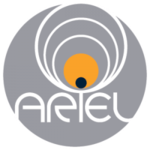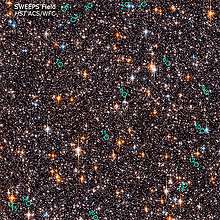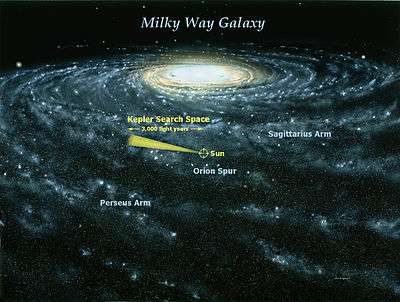ARIEL
The Atmospheric Remote-sensing Infrared Exoplanet Large-survey (ARIEL), is a space telescope planned for launch in 2028 as the fourth medium-class mission of the European Space Agency's Cosmic Vision programme. The mission is aimed at observing at least 1,000 known exoplanets using the transit method, studying and characterising the planets' chemical composition and thermal structures. Compared to James Webb Space Telescope, ARIEL will have more observing time available for planet characterisation but a much smaller telescope.
| Mission type | Space telescope |
|---|---|
| Operator | ESA · ARIEL Consortium |
| Website | ariel-spacemission |
| Mission duration | 4 years[1] |
| Spacecraft properties | |
| Launch mass | ~1,300 kg (2,900 lb)[2] |
| Dry mass | ~950 kg (2,090 lb) |
| Payload mass | ~300 kg (660 lb) |
| Start of mission | |
| Launch date | 2028 |
| Rocket | Ariane 6-2 |
| Launch site |
|
| Contractor | Arianespace |
| Main Cassegrain reflector | |
| Diameter | oval: 1.1 m × 0.7 m |
| Collecting area | 0.64 m2 |
| Wavelengths | visible and near-infrared |
 Official mission insignia | |
Mission
ARIEL will observe 1,000 planets orbiting distant stars and make the first large-scale survey of the chemistry of exoplanet atmospheres.[3] The objective is to answer fundamental questions about how planetary systems form and evolve.[4] A spectrometer will spread the light into a spectrum ('rainbow') and determine the chemical fingerprints of gases in the planets' atmospheres.[4] This will enable scientists to understand how the chemistry of a planet links to the environment in which it forms, and how its formation and evolution are affected by its parent star.[4] ARIEL will study a diverse population of exoplanets in a wide variety of environments, but it will focus on warm and hot planets in orbits close to their star.[4]
The ARIEL mission is being developed by a consortium of various institutions from eleven member states of the European Space Agency (ESA),[lower-alpha 1] and international contributors from four countries.[lower-alpha 2] The project is led by principal investigator Giovanna Tinetti of the University College London,[6][7] who had previously led the unsuccessful Exoplanet Characterisation Observatory (EcHO) proposal for the M3 Cosmic Vision launch slot.[8][9] Operations of the mission and the spacecraft will be handled jointly by ESA and the consortium behind the mission's development, through a coordinated Instrument Operations and Science Data Centre (IOSDC).[5] A Mission Operations Centre (MOC) will be set up at the European Space Operations Centre (ESOC) in Darmstadt, Germany, while a concurrent ARIEL Science Operations Centre (SOC) will be set up at the European Space Astronomy Centre (ESAC) near Madrid, Spain.[5] The MOC will be responsible for the spacecraft itself, while the SOC will be responsible for archiving mission data and scientific data downlinked from the spacecraft. The IOSDC will help develop results from the mission based on data received by the SOC.[5]
In August 2017 NASA conditionally selected Contribution to ARIEL Spectroscopy of Exoplanets (CASE) as a Partner Mission of Opportunity, pending the result of ESA's Cosmic Vision selection.[10] Under the proposal NASA would provide two fine guidance sensors for the ARIEL spacecraft in return for the participation of US scientists in the mission.[11] CASE was officially selected in November 2019, with JPL astrophysicist Mark Swain as principal investigator.[12]
Spacecraft
The design of the ARIEL spacecraft is based on that intended for the Exoplanet Characterisation Observatory (EChO) mission, and has heritage from the thermal design of Planck.[5][13] The body of the spacecraft is split into two distinct modules known as the Service Module (SVM) and the Payload Module (PLM). The SVM is shaped as a 'sandwich' structure, consisting of three aluminum V-Grooves and three pairs of low conductivity fibreglass bipod struts supporting the PLM.[13] A basic horizontal telescope configuration is used for the PLM itself, housing all of the spacecraft's scientific instruments and its oval 1.1 × 0.7 metre (3.6 × 2.3 feet) primary mirror.[13][14] At launch, the spacecraft will have a fuelled mass of ~1,200 kilograms (2,600 lb), and will have a dry mass of ~950 kilograms (2,090 lb).[14] The PLM will account for around 300 kilograms (660 lb) of that mass.[14]
Telescope
The ARIEL telescope's assembly is an off-axis Cassegrain telescope followed by a third parabolic mirror to recollimate the beam. The telescope uses an oval 1.1 × 0.7 metre (3.6 × 2.3 feet) primary mirror; the system has a diffraction limit of about 3 µm, and a focal ratio (f) of 13.4.[15] The system will acquire images in the visible and near-infrared spectrum.[15] To operate its infrared spectroscope between 1.95 µm and 7.8 µm, the telescope will be passively cooled to a temperature of 55 K (−218.2 °C; 55.0 K).[5][15]
Launch and trajectory
The ARIEL spacecraft is expected to be launched in mid-2028 by Arianespace's Ariane 6-2 rocket,[16][17] currently in development.[18][19] It will be launched from the Guiana Space Centre in Kourou, French Guiana,[16][17] from the Ensemble de Lancement Ariane 4 (Ariane Launch Area 4) being purpose-built for future Ariane 6 launches.[20] ARIEL will be launched to the L2 Lagrangian point, in a position located at a distance of 1,500,000 kilometres (930,000 mi) from Earth,[16] where it will encounter a very stable thermal environment that is required to detect exoplanets.[17]
See also
- CHEOPS and PLATO – Cosmic Vision exoplanetology missions
- FINESSE – NASA equivalent to ARIEL
- Comet Interceptor – Launching on the same rocket
- List of space telescopes
References
Notes
- These are the University of Vienna from Austria, the Universities of Leuven and Liège from Belgium, the Technical University of Denmark, the CEA, CNES, Paris Institute of Astrophysics, Marseille, Côte d'Azur, and Paris Observatories in France, the Max Planck Society and University of Hamburg in Germany, SRON and the Universities of Amsterdam, Delft, and Leiden in the Netherlands, the Space Research Centre of Polish Academy of Sciences, the CAB, Institute of Space Sciences and the Institute of Astrophysics of the Canary Islands in Spain, University of Bern in Switzerland, and the ATC and the Universities of Cardiff, Exeter, Hertfordshire, Keele, Leicester, London, and Oxford in the United Kingdom.[5]
- These are the Universities of Montréal and Toronto in Canada, the ELSI, Tokyo Institute of Technology, and Osaka University in Japan, the National Autonomous University of Mexico, and Caltech, the LPL and JPL, Lunar and Planetary Institute, and Universities of Arizona State, Chicago, and Princeton in the United States.[5]
Citations
- ARIEL Summary. ESA.
- ARIEL Spacecraft. ESA.
- ARIEL Space Mission - A Candidate for the ESA M4 Mission. 2018.
- ARIEL exoplanet mission selected as ESA’s next medium-class science mission. World Press. 20 March 2018.
- European Space Agency, ARIEL Science Study Team (March 2017). "(ESA/SCI(2017)2) ARIEL – Atmospheric Remote‐sensing Infrared Exoplanet Large‐survey" (PDF). ARIEL Science Mission. ARIEL Consortium. Archived from the original (PDF) on 22 March 2018. Retrieved 22 March 2018.
- Amos, Jonathan (20 March 2018). "Discovering the nature of planets". BBC News. British Broadcasting Corporation. Archived from the original on 22 March 2018. Retrieved 22 March 2018.
- Gibney, Elizabeth (20 March 2018). "First space mission dedicated to exoplanet atmospheres gets green light". Nature. Nature Publishing Group (Holtzbrinck Publishing Group). Archived from the original on 22 March 2018. Retrieved 22 March 2018.
- Gewin, Virginia (14 April 2011). "Turning point: Giovanna Tinetti". Nature. Nature Publishing Group (Holtzbrinck Publishing Group. 472 (7342): 251. doi:10.1038/nj7342-251a. ISSN 1476-4687.
- European Space Agency (21 February 2014). "ESA selects planet-hunting PLATO mission". Astronomy. Kalmbach Publishing. Archived from the original on 22 March 2018. Retrieved 22 March 2018.
- "NASA Selects Proposals to Study Galaxies, Stars, Planets". Jet Propulsion Laboratory. Retrieved 28 April 2018.
- "FINESSE and ARIEL + CASE: Dedicated Transit Spectroscopy Missions for the Post-TESS Era" (PDF). NASA Cosmic Origins Program Analysis Group (COPAG). Retrieved 28 April 2018.
- Landau, Elizabeth (8 November 2019). "NASA Instrument to Probe Planet Clouds on European Mission". NASA. Retrieved 12 November 2019.
- Science & Technology Portal staff (20 March 2018). "ARIEL: Spacecraft". ESA Science & Technology Portal. European Space Agency. Archived from the original on 22 March 2018. Retrieved 22 March 2018.
- ARIEL Space Mission staff (May 2017). "Facts & Figures". ARIEL Space Mission. ARIEL Consortium. Archived from the original on 22 March 2018. Retrieved 22 March 2018.
- ARIEL - Payload. ESA. 20 March 2018.
- Science & Technology Portal staff (20 March 2018). "ESA's next science mission to focus on nature of exoplanets". ESA Science & Technology Portal. European Space Agency. Archived from the original on 22 March 2018. Retrieved 22 March 2018.
- Warren, Melissa (20 March 2018). "UK part of ARIEL exoplanet project selected as ESA's next medium-class science mission". Science and Technology Facilities Council. Her Majesty's Government. Archived from the original on 22 March 2018. Retrieved 22 March 2018.
- Amos, Jonathan (22 June 2017). "Full thrust on Europe's new Ariane 6 rocket". BBC News. British Broadcasting Corporation. Archived from the original on 22 March 2018. Retrieved 22 March 2018.
- Pultarova, Tereza (25 October 2017). "ArianeGroup CFO Pierre Godart on Ariane 6 cost savings, micro launchers and reusability". SpaceNews. Pocket Ventures, LLC. Archived from the original on 22 March 2018. Retrieved 22 March 2018.
- Euronews staff (14 December 2017). "Race to build Ariane 6 rocket launch pad". Euronews. Media Globe Networks and NBCUniversal. Archived from the original on 22 March 2018. Retrieved 22 March 2018.


.png)